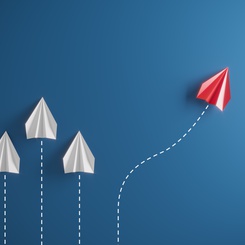With ESSEC Knowledge Editor-in-chief
We’ve all heard of the honeymoon phase that occurs in a new relationship – and the classic warning that it doesn’t last. We know that it’s normal for relationships to evolve with time, and business relationships are no different. As is the case with all relationships – be they business, familial, or romantic – the buyer-supplier relationships change over time. Ali Shamsollahi (ESSEC Business School), Danielle A. Chmielewski-Raimondo (University of Melbourne), Simon J. Bell (University of Melbourne) and Reza Kachouie (Deakin University) examined this in their recent article by conducting a thorough review exploring the buyer-supplier relationship dynamics.
Managing marketing channel relationships is a crucial part of running a business: the company must have strong relationships with buyers and suppliers to maintain a competitive advantage. It benefits companies to understand how these relationships change over time: that’s where Dr. Shamsollahi and his colleagues come in. Having identified the fragmented and scarce knowledge about buyer-supplier relationship dynamics, they delved into this by conducting a systematic literature review, reviewing hundreds of articles, and ultimately including 61 in their final analysis. Their research uncovered four main themes: relationship continuity, relationship learning, relationship stages and trajectories, and relationship fluctuations.
What makes relationships last?
The first, relationship continuity, explores how and why firms transition from a temporary or one-off relationship to one that endures long-term. We can further divide this into two sub-themes, the drivers of continuity and the effects of expecting continuity. Drivers of continuity can be exogenous – outside the control of both buyer and supplier – or endogenous, which are factors influenced by the firms. Exogenous drivers can positively impact continuity, for example, if they involve high-stakes or complex deals, or a negative one, if they involve market uncertainty, poor reputations, or power imbalances. Endogenous factors come from within and can be one-sided or jointly determined: they include factors like trust, dependence, and relationship-specific assets, that inform parties’ perception of their relationship’s continuity. This expectation of continuity was also examined, both for its positive and negative effects, to see how expecting continuity impacts actual continuity. A key takeaway is that expecting continuity increases mutual investment in the relationship and boosts cooperation, coordination, and trust while decreasing parties’ ambiguity about their roles. This is specifically important as organizations in long-term relationships with little expectation for continuity might lose their objectivity toward the relationship, experience lower trust, and act opportunistically; this is where the relationship’s dark side might set in.
Learning together, growing together
The second emergent theme is relationship learning. The review uncovered three components of relationship learning: its impact on relationship governance, the impact of knowledge sharing on buyer-supplier relationship performance, and information sharing speed between firms. The first refers to how learning about each other’s traits leads to the modification of relationship governance mechanisms, such as updating the contract as the relationship memory; or the way mutual trust can complement how contracts are drafted. Knowledge sharing refers to the fact that as relationships mature, they begin to share knowledge and learn together. That being said, parties’ self-interest also tends to increase over time, which can then reduce knowledge sharing – the process that can be impacted by factors other than self-interest, such as culture. With the third component, speed of information sharing, we learn how its speed is only as fast as the weakest link and that this, in turn, affects innovation and communication cost. Together, the research on relationship learning clarifies why some buyer-supplier relationships perform better than others and highlight the importance of learning and sharing knowledge.
After the honeymoon phase: Relationship stages and trajectories
As mentioned above, it is no surprise that relationships go through different stages, so it is only natural that another research theme identified involved relationship stages and trajectories. This can be further divided into sub-themes of relationship development through stages and cycles, relationship trajectories and trends, and the emergence of relationships’ initial conditions through spirals. Dr. Shamsollahi and his colleagues found two main schools of thought when it comes to researching relationship stages over time. The first posits that the relationship development process is an ongoing cycle of negotiation, commitment, and execution. The second and more common perspective is that relationships go through various stages and that characteristics like trust change or develop at each stage and go through an inverted U-shaped trajectory. Yet, there is contradictory evidence regarding this finding and the assumption of relationship stages. For example, researchers have illustrated the possibilities of backward trajectories or cycles within relationship stages. Other researchers have found that the truth is more complicated, as some factors – like trust – are between individuals, whereas others – like commitment – are between the organizations. They also have found evidence of a honeymoon trend, with a burst of goodwill at the beginning of a relationship. Another trend identified is spiral, meaning a relationship will follow a path determined by past choices, forming a spiral or a loop, and getting into a routine, even when the routine is not ideal.
Fluctuations
The fourth and final theme is that of fluctuations, meaning anomalies in the trajectory of a relationship. These are often linked to specific incidents like positive experiences, crises, or conflicts. The literature has examined three main questions: the temporal factors that influence how parties in a relationship resolve conflict and maintain their relationship, the timing of an incident and its subsequent impact, and the cumulative effect of several similar incidents. For example, temporal factors, like a manager’s relationship tenure, can impact whether or not parties decide to put effort into repairing their relationship after a conflict. Further, a damaged party’s quick reactions can prevent adverse events from happening or mitigate the result. We know that timing is everything, which is supported by the research: whether an incident occurs at the beginning or end of a relationship impacts how it is dealt with. This is also important to consider the relationship history. When a relationship has experienced several similar incidents, it can impact how parties view each other: if one thinks that the other is particularly conflict-prone, they tend to decrease their communications with the other, and transactions tend to become costlier.
What does this all mean?
So, where do we go from here? We now have a framework as a dynamic lens that can be applied to static research questions around B2B relationships. For example, Dr. Shamsollahi and his colleagues have showcased this by applying this lens to the analysis of relationship transgression and repair, and to compare how relationships are governed, be they more relational or formal. They have provided eight conceptual models to speed up the research in buyer-supplier relationship dynamics. It can also be used outside of a buyer-supplier context and applied to the relationship a business has with any external stakeholder.
Tips for managers
1. Keep in mind that trust and transaction-specific assets are key to relationship continuity.
2.It is wise to monitor your interlocutor to get a sense of if they see the relationship as long-term: if not, even in the presence of positive relationship history, the company risks being exposed to opportunistic behaviors. In this case, managers should not rely on relational mechanisms such as trust and consider implementing formal contracts as safeguards.
3. Contracts can also serve as a sort of organizational memory tool. By tracking contract modifications over time, managers can use this archive to expedite the development of new relationships.
4.Be vigilant about the initial conditions of the relationship. This comes back to the spirals mentioned above, and the path dependency. Something like signing a new contract with the same organization can lead to positive initial conditions and protect the relationship from early termination.
References
Shamsollahi, A., Chmielewski-Raimondo, D. A., Bell, S. J., & Kachouie, R. (2020). Buyer–supplier relationship dynamics: a systematic review. Journal of the Academy of Marketing Science, 1-19.









